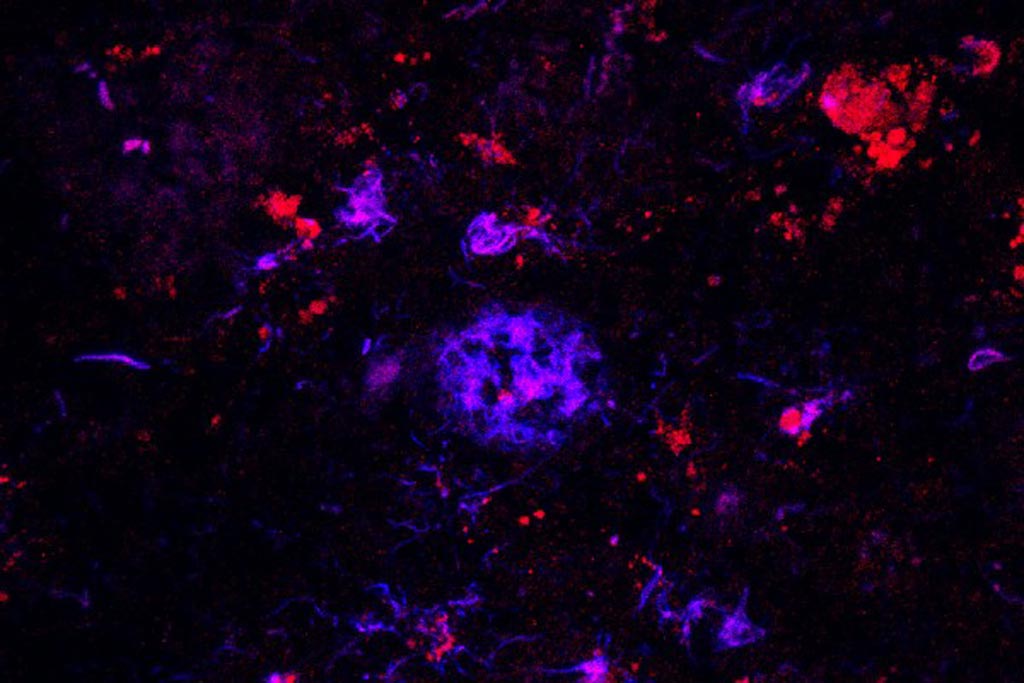Antibody Clears Amyloid Plaques in Mouse Model
By LabMedica International staff writers
Posted on 10 Apr 2018
A team of Alzheimer's disease researchers working with a mouse model identified a specific antibody capable of binding to and mediating the removal of the amyloid plaques that characterize this catastrophic neurodegenerative disorder.Posted on 10 Apr 2018
The apolipoprotein E E4 allele of the APOE gene is the strongest genetic factor so far discovered for late-onset Alzheimer disease (LOAD). Previous studies have provided evidence that apoE influenced Alzheimer disease (AD) in large part by affecting amyloid beta (Abeta) aggregation and clearance; however, the molecular mechanism underlying these findings remains largely unknown.

Image: Antibodies against APOE (red) bind to amyloid plaques (blue) in brain tissue from people with Alzheimer\'s disease. Investigators have found that the antibody can sweep away the damaging plaques, at least in mice, which could lead to a therapy for the devastating disease (Photo courtesy of Monica Xiong, Washington University School of Medicine).
To increase understanding of the role of apoE in AD, investigators at Washington University School of Medicine (St. Louis, MO, USA) examined whether anti-human apoE antibodies could decrease Abeta pathology in mice producing both human Abeta and apoE4, and investigated the mechanism underlying these effects. To do this, the investigators utilized APPPS1-21 mice crossed to apoE4-knockin mice expressing human apoE4 (APPPS1-21/APOE4).
The investigators reported in the March 30, 2018, online edition of the Journal of Clinical Investigation that they had discovered an anti-human apoE antibody, anti-human apoE 4 (HAE-4), that specifically recognized human apoE4 and apoE3 and preferentially bound non-lipidated, aggregated apoE over the lipidated apoE found in circulation. HAE-4 also bound to apoE in amyloid plaques in unfixed brain sections and in living APPPS1-21/APOE4 mice.
When delivered centrally or by peripheral injection, HAE-4 reduced Abeta deposition in APPPS1-21/APOE4 mice. Using an adeno-associated virus vector to express two different full-length anti-apoE antibodies in the brain, they found that HAE antibodies decreased amyloid accumulation, which was dependent on Fcgamma receptor function.
These data tended to support the hypothesis that a primary mechanism for apoE-mediated plaque formation was a result of apoE aggregation, as preferentially targeting apoE aggregated with therapeutic antibodies reduced Abeta pathology and may represent a selective approach to treat AD.
“Many people build up amyloid over many years, and the brain just cannot get rid of it,” said senior author Dr. David Holtzman, professor of neurology at Washington University School of Medicine. “By removing plaques, if we start early enough, we may be able to stop the changes to the brain that result in forgetfulness, confusion, and cognitive decline.”
“It turns out that the APOE in the plaques has a different structure than the form of APOE found in the blood,” said Dr. Holtzman. “The anti-amyloid antibodies are going to be binding to most of the molecules that are in the plaque, but the anti-APOE antibody would target just a very small component of the plaque. This means we may find less immune activation, and we might not see the unwelcome side effects.”
Related Links:
Washington University School of Medicine














